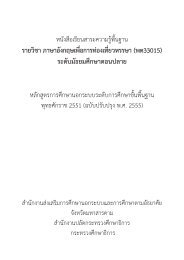bahasa indonesia
djenar-2003-a-students-guide-to-indonesian-grammar-oxford
djenar-2003-a-students-guide-to-indonesian-grammar-oxford
- No tags were found...
Create successful ePaper yourself
Turn your PDF publications into a flip-book with our unique Google optimized e-Paper software.
Introduction<br />
I<br />
A Student's Guide to Indonesian Grammar is intended for secondary<br />
'students in Years 10-12 and for tertiary students beginning Indonesian. It<br />
presents grammai in an accessible &d fun way by focusing on its use in<br />
daily communication. Many of the exercises in this book are designed for<br />
pair or group interaction, while others are suitable for independent<br />
learning. '<br />
The earlier chapters in the book cover lighter topics, such as asking and<br />
answering questions, numbers and prepositions. Subsequent chapters cover<br />
more difficult topics. Teachers may wish to use the easier chapters in the<br />
early part of the year as a warm-up, if their students have already studied<br />
the topics beforehand, then move on to other chapters. Each chapter is selfcontained,<br />
allowing teachers to select topics to coincide with other teaching<br />
materials. Cross-referencing within and between chapters provides easy<br />
access to related grammatical points.<br />
Each ch'apter in this book covers one grammatical topic. For each part of<br />
the topic, an explanation is given, supported by examples. Exercises<br />
(Latihan) provide immediate reinforcement of the grammar learnt.<br />
Vocabulary (Kosakata) is given for many of the exercises. Where a<br />
dictionary may be required, this is clearly specified.<br />
Grammar is an integral part of language use. It forms part of how people<br />
communicate with each other in daily life. Often a communicative situation<br />
determines people's choice of words and way of saying things. For<br />
example, people may speak differently in informal and formal situations. In<br />
addition, people may write differently from the way they speak. The<br />
communicative dimensions are complex and are impossible to be dealt<br />
with comprehensively in a book of this sort. However, throughout this<br />
book, in the explanations of grammatical topics and in the accompanying<br />
exercises, indications are provided as to the situations in which certain<br />
language uses are most appropriate.<br />
Additional information is given under the following headings.<br />
Did you know?<br />
Note<br />
Handy expression<br />
Be careful!<br />
This information relates to useful expressions, cultural notes and errors to<br />
avoid, which students and teachers may find interesting and helpful.<br />
The introduction of grammatical terms is unavoidable in a grammar book<br />
and some learners may find this rather daunting. In this book, grammatical<br />
terms are used only where no simpler alternative is available. Grammatical<br />
terms introduced for the first time are it'alicised and an explanation of the<br />
term is provided.



